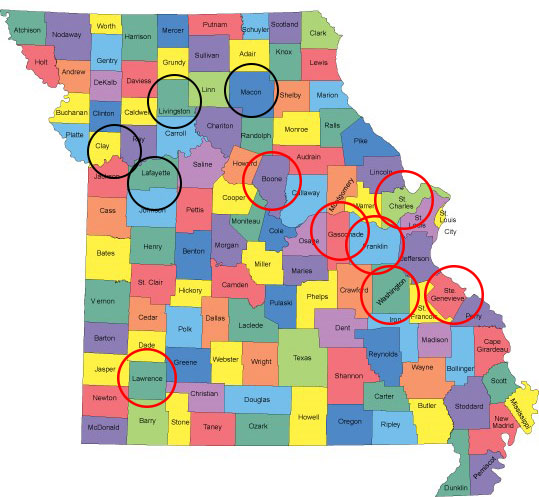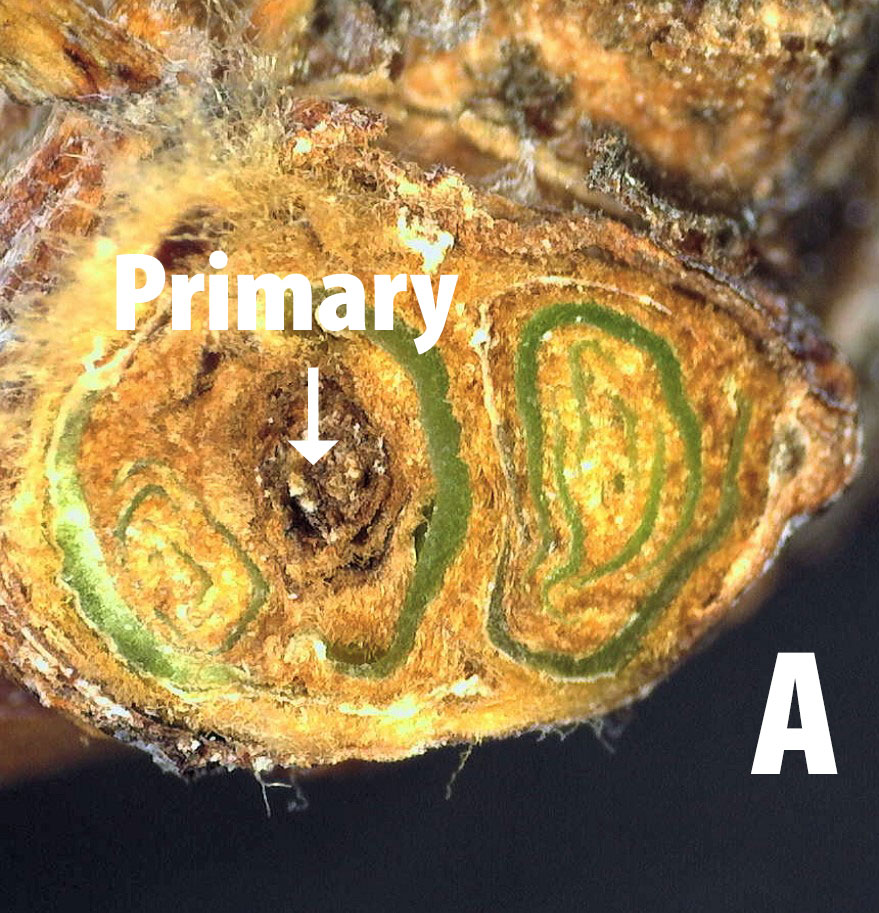Vinews
No. 2 — March 25, 2019
Contents:
Bud Mortality Update
Over the past week, grape cultivars were evaluated for bud mortality from Central, East Central and South Western Missouri. Counties include Boone, St. Charles, Gasconade, Franklin, Washington, Ste. Genevieve and Lawrence.

Results: Week of March 25, 2019
Primary bud mortality on average was 22 percent of the 31 samples evaluated (Table 1). Traminette, four Vitis vinifera cultivars combined, Chambourcin and Chardonel had the greatest bud mortality. Traminette had a bud mortality of 30 percent. Bud mortality for Chambourcin ranged from 11 to 39 percent, with the average of 9 samples being 24 percent. Chardonel bud mortality ranged from 12 to 46 percent, with the average of 5 samples being 29 percent. The average bud mortality of the four V. vinifera cultivars was 28 percent, whereas Concord had a bud mortality of 4 percent.
Table 1. Bud mortality of grape cultivars from northwest and northcentral Missouri during the week of 25 March 2019.
| Cultivar | County | Morality %1 |
|---|---|---|
| Chambourcin | Franklin | 11 |
| Franklin2 | 24 | |
| Gasconade | 37 | |
| Gasconade | 19 | |
| Gasconade | 20 | |
| Lawrence | 33 | |
| St. Charles | 39 | |
| Ste. Genevieve | 15 | |
| Washington | 15 | |
| Average 24 | ||
| Chardonel | Boone2 | 28 |
| Gasconade | 29 | |
| Gasconade | 31 | |
| St. Charles | 12 | |
| Ste. Genevieve | 46 | |
| Average 29 | ||
| Concord | Gasconade | 4 |
| Norton | Boone2 | 15 |
| Gasconade | 8 | |
| Average 12 | ||
| Traminette | Boone2 | 30 |
| Vidal blanc | Boone2 | 14 |
| Washington | 8 | |
| Average 11 | ||
| Vignoles | Boone2 | 16 |
| Franklin2 | 14 | |
| Franklin | 37 | |
| Gasconade | 16 | |
| Lawrence | 19 | |
| Washington | 24 | |
| Average 21 | ||
| Vincent | Gasconade | 15 |
| Cabernet Franc | St. Charles | 34 |
| Lemberger | St. Charles | 18 |
| Saperavi | St. Charles | 32 |
| Viognier | Ste. Genevieve | 32 |
| Average 28 | ||
1 % based on the examination of 100 buds from 20 randomly selected canes. Five count buds were examined per cane for primary bud mortality.
2 Bud mortality submitted by collaborators.
Results: Week of March 18, 2019. Reprinted for comparison
Primary bud mortality on average was 21 percent of the 18 samples evaluated (Table 2). Chambourcin and Chardonel had the greatest bud mortality. Bud mortality for Chambourcin ranged from 14 to 75 percent, with the average of 5 samples being 41 percent. Only one sample of Chardonel was evaluated, and the bud mortality was 34 percent. Bud mortality for Vignoles ranged from 8 to 23 percent, with the average bud morality being 13 percent among five samples. Three samples of Norton were evaluated and the average bud mortality was 11 percent.
Table 2. Bud mortality of grape cultivars from northwest and northcentral Missouri during the week of 18 March 2019.
| Cultivar | County | Morality %1 |
|---|---|---|
| Chambourcin | Clay/Ray | 34 |
| Lafayette | 14 | |
| Lafayette | 15 | |
| Macon | 66 | |
| Macon | 75 | |
| Average 41 | ||
| Chardonel | Macon | 34 |
| Crimson Cabernet | Clay/Ray | 14 |
| Elvira | Livingston | 3 |
| Norton | Lafayette | 11 |
| Macon | 11 | |
| Waverly | 10 | |
| Average 11 | ||
| Verona | Macon | 0 |
| Vignoles | Clay/Ray | 9 |
| Lafayette | 12 | |
| Lafayette | 15 | |
| Livingston | 23 | |
| Macon | 8 | |
| Average 13 | ||
| Wine King | Livingston | 22 |
1 % based on the examination of 100 buds from 20 randomly selected canes. Five count buds were examined per cane for primary bud mortality.
Assessing bud mortality in your vineyard
To accurately assess the health of the bud tissue use a sharp razor blade and make a cross-section cut about 1/3 to 1/2 of the height from the bud tip. Realize the primary bud is in the center of the bud, the secondary bud is located towards the base of the cane and the tertiary bud is located towards the tip of the cane (Figure 1). If the center of the primary bud is brown or black in color the primary bud is dead. Careful not to cut to deep or you will reveal the bud plate which will be green. A quick assessment of 10 to 20 count buds in the vineyard will provide you a rapid assessment. If damage is found then you should evaluate 100 count buds to get an accurate assessment of primary bud damage.


How to manage vines with bud mortality
| Primary bud mortality, % | Adjustment to dormant pruning |
|---|---|
| 0 to 15 | none |
| 20-30 | Add 20-30% more count buds |
| 40-50 | Double count buds |
| 60+ | No dormant pruning |
Table adopted from “Assessing and managing grapevines in response to winter injury” by Thomas J. Zabadal, MSU Department of Horticulture: https://www.canr.msu.edu/uploads/files/Vineyard_management/AssessWinterInjury.pdf
Managing bud mortality commentary
If your vines have experienced primary bud mortality between 20 to 30 percent, then it would be best to leave approximately 30 percent more count buds. If, on the other hand, you have completed pruning and your vines have experienced primary bud death, what is the solution? Looking back to what occurred during the Easter freeze of 2007 does provide some insight. My good friend Eli Bergmeier reminded me that both Chambourcin, Chardonel and Vidal blanc will produce some fruit from secondary buds. In fact, when most of the primary shoots were destroyed during the Easter freeze of 2007, Chambourcin, Chardonel and Vidal blanc had crop levels of approximately 60 percent, compared to normal (Understanding and preventing freeze damage in vineyards, University of Missouri-Columbia, Dec. 5-6, 2007). You may then raise concern about asynchronous ripening of fruit produced from shoots from primary and secondary buds. There may be some lag time from fruit developing on secondary bud shoots. However, most of Missouri experiences more than enough GDD to ripen fruit (except for the northern areas), more than likely the fruit clusters produced on secondary shoots will approach harvest maturity shortly after the clusters on the primary shoots.
If your vines experienced extreme primary bud mortality, then there likely is another issue that you need to concern yourself. In most cases, when primary bud mortality is above 60 percent and the temperatures during November through February were not extreme, a vascular problem is the likely culprit. For Chambourcin, the most likely culprit is Crown gall. The solution to Crown gall is to start bringing up new trunks if your Chambourcin in growing on its own roots.
Also, if your vines experienced primary bud mortality greater than 60 percent, then consider simply hedging the vines to approximately five-bud canes. This results in keeping the vines in better balance in the future years.